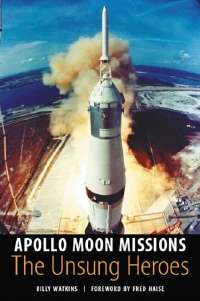|
|
Review: Apollo Moon Missions: The Unsung Heroes
by Jeff Foust
Monday, December 10, 2007
Apollo Moon Missions: The Unsung Heroes
by Billy Watkins
University of Nebraska Press, 2007
softcover, 248 pp., illus.
ISBN 978-0-8032-6041-2
US$17.95
Last Friday, December 7, was the 66th anniversary of the Japanese attack on Pearl Harbor, a day that did indeed live in infamy. However, the day was also the anniversary of another event that, over the years, has become not infamous but ignominious: the launch of Apollo 17, the last time human beings have traveled to the Moon. In the last 35 years something approaching a cult of hero worship has emerged, focused primarily on the astronauts who traveled to or set foot upon the Moon. It would be hard to argue that these people are not worthy of such praise, given that they put their lives at risk for a goal that was noble yet also a national priority at the time. The fact that these people are still so revered, more than a third of a century later, says something about the magnitude of their achievement—and, perhaps, what little has been accomplished in comparison in the decades that followed.
However, that hero worship rarely extends beyond the astronauts who flew the Apollo missions. Other than a handful of engineers, managers, controllers, and technicians (such as Wernher von Braun and Gene Kranz), most of those involved in Apollo—a figure exceeding 400,000 at its peak—toiled in anonymity. While the astronauts’ tales have been told countless times in books, documentaries, and movies, rarely have those behind the scenes had a chance to tell how they helped make Apollo a success. Journalist Bill Watkins helps rectify that to some degree with his book Apollo Moon Missions: The Unsung Heroes.
| The book makes its point clear: that for each of men both skilled and fortunate enough to travel to the Moon, there were thousands more on Earth who made it possible but would never get the recognition the astronauts received. |
The book, as its title suggests, looks at those “heroes” not in the public limelight that helped make Apollo possible. Fourteen people are profiled in the book, spanning a vast range of people and roles. Bruce McCandless was the Apollo 11 capcom who later flew on the space shuttle, becoming the first astronaut to make an untethered spacewalk with the MMU. Steve Bales was the 26-year-old guidance officer for Apollo 11 (he considered Neil Armstrong, at the ripe old age of 38, “ancient” at the time) who had to sweat out the program alarms during the lunar module’s descent to the surface. Joe Schmitt was a technician who helped get the astronauts suited up for their flights. Hugh Brown and JoAnn Morgan played supporting roles, but stood out because of his race (African American) and her gender. Each chapter of the book is a miniature biography, as the person profiled describes not only their roles on Apollo but the path they followed both before and after the program.
The selection of people in Apollo Moon Missions: The Unsung Heroes is somewhat random: Watkins writes in the introduction that he settled on 14 for symbolic reasons, representing the 12 astronauts who walked on the Moon and the two on Apollo 13 who planned to but could not because of the accident en route. However, the book makes its point clear: that for each of men both skilled and fortunate enough to travel to the Moon, there were thousands more on Earth who made it possible but would never get the recognition the astronauts received. “You know, the astronauts have been interviewed to death,” Apollo astronaut John Young said (in, ironically, an interview with Watkins mentioned in the book’s preface.) “But there were so many people who helped us go to the Moon and bring us back, and nobody knows anything about them. You should find some of those people and write about them.” Watkins, of course, did just that, and the result is this book: a glimpse at who those unknown thousands working on Apollo were.
Jeff Foust (jeff@thespacereview.com) is the editor and publisher of The Space Review. He also operates the Spacetoday.net web site and the Space Politics and Personal Spaceflight weblogs. Views and opinions expressed in this article are those of the author alone, and do not represent the official positions of any organization or company, including the Futron Corporation, the author’s employer.
|
|
